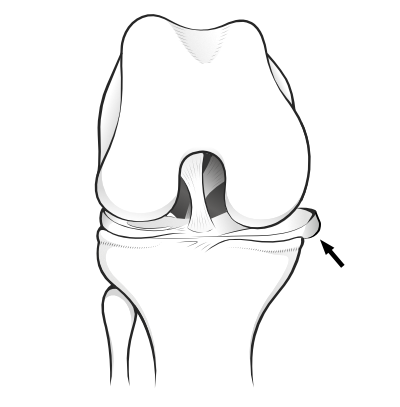Meniscal extrusion is when the meniscus becomes loose from its moorings and slips out over the edge of the top of the tibia.
 Page updated October 2023 by Dr Sheila Strover (Clinical Editor)
Page updated October 2023 by Dr Sheila Strover (Clinical Editor)

Normally the meniscus is held in place by the meniscal roots and ligaments at the horns, and meniscotibial and meniscofemoral ligaments around much of the edge. If its moorings become incompetent, normal vertical pressure pushes the meniscus body over the edge of the tibial plateau, leaving the bones in contact with one another.
What is the cause of meniscal extrusion?
Tear of the posterior root of the medial meniscus is a common cause of extrusion.
After such an injury the meniscus may become incompetent at absorbing the vertical forces that go through the joint. The extrusion is usually detected radiologically.
Several factors may lead to extrusion:
- meniscal root avulsion
- disruption of the meniscus fibres from injury
- degeneration of the meniscus fibres from age
Meniscal extrusion and knee arthritis
As the meniscus slips over the edge of the tibia, it becomes totally incompetent as a shock absorber, and the cartilage covering the bones may rapidly become stressed and damaged, resulting in arthritis. Arthritis can develop very quickly as the joint cartilage of femur and tibia break down.
Quick links
Peer-reviewed papers
-
Quote:
"Meniscal extrusion on MRI scan is defined as ≥3 mm of external displacement of the meniscus with respect to the central outer rim or edge of the tibial plateau quantified in the midcoronal plane for an unloaded knee...Due to convexity of the lateral femoral and tibial condyles, the lateral compartment is more adversely affected than the medial."
Citation: Gajjar SM, Solanki KP, Shanmugasundaram S, Kambhampati SBS. Meniscal Extrusion: A Narrative Review. Orthop J Sports Med. 2021 Nov 3;9(11):23259671211043797. doi: 10.1177/23259671211043797. PMID: 34778470; PMCID: PMC8573502.
 2019 -
2019 -